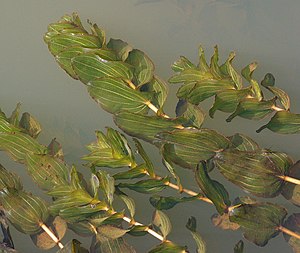Streaky pondweed
| Streaky pondweed | ||||||||||||
|---|---|---|---|---|---|---|---|---|---|---|---|---|

Streaky pondweed |
||||||||||||
| Systematics | ||||||||||||
|
||||||||||||
| Scientific name | ||||||||||||
| Potamogeton perfoliatus | ||||||||||||
| L. |
The streaky pondweed ( Potamogeton perfoliatus ) belongs to the family of the pondweed plants (Potamogetonaceae). It is a diving leaf plant rooted on the bottom of the water.
features
Streaked pondweed develops - depending on the water depth - up to six meters long, straight, branched stems. The leaves, which grow exclusively submerged , are ovate-lanceolate to circular, quite large (6 to 12 centimeters long, 3.5 to 6 centimeters wide), light to dark green, veined and translucent. They are characteristically heart-shaped, encompassing stems and almost covering each other like roof tiles. The species forms from June to August, dense inflorescences with inconspicuous greenish flowers. These ears become one to three centimeters long, stick out of the water for the purpose of wind pollination and finally produce plenty of fruit. The fruits (nuts) are quite thick at two to three millimeters.
The number of chromosomes is 2n = 52.
distribution
Potamogeton perfoliatus is widespread in the temperate to cool zones of the northern hemisphere and occurs southward to Sumatra. Europe (largely excluding the Mediterranean region), North Asia and North America are populated in several subspecies. In Central Europe, the main area of distribution is in the lowlands, namely in the large river plains and, for example, in the Mecklenburg Lake District . In the Alps, the streaky pondweed occurs up to an altitude of 1680, according to other sources up to 1900 meters. In general, however, it is rare in the mountains.
Habitat, ecology
The species grows in stagnant and slowly flowing waters such as lakes, ditches, oxbow lakes , canals and rivers. It prefers base and nutrient-rich waters with humus muddy, muddy or sandy soil and colonizes depths of 50 to 700 centimeters - often in pure stands, but also associated with other spawning herbs as well as other diving and floating leaf plants. Potamogeton perfoliatus is a species belonging to the large spawning herb communities (Potamogetonetalia). A certain degree of pollution and cloudiness of the water is tolerated. However, with excessive eutrophication , the plant disappears. It is therefore on some regional red lists .
As is typical for some spawning herbs , the shoots die in autumn and the species survives with the help of previously formed winter buds , which detach, sink to the bottom of the water and develop into new plants in the following year. In lime-rich waters, the leaves are often covered with a light gray crust of carbonate of lime, which the aquatic plant precipitates from the water when it is assimilated .
Systematics
Streaky pondweed can hybridize with some other species of large pondweed : The hybrid of Potamogeton perfoliatus and the specular pondweed ( Potamogeton lucens ) becomes "Willow-leaved pondweed", Potamogeton × salicifolius Wolfg. , called, the hybrid with the participation of the grass-leaved pondweed ( Potamogeton gramineus ) is called "shimmering pondweed", Potamogeton × nitens Weber .
swell
literature
- Henning Haeupler , Thomas Muer: picture atlas of the fern and flowering plants of Germany (= the fern and flowering plants of Germany. Volume 2). Published by the Federal Agency for Nature Conservation. Ulmer, Stuttgart 2000, ISBN 3-8001-3364-4 .
- Heinz-Dieter Krausch : Color atlas of water and bank plants. Ulmer, Stuttgart 1996, ISBN 3-8001-3352-0
- Erich Oberdorfer : Plant-sociological excursion flora. 6th edition, Ulmer, Stuttgart 1990, ISBN 3-8001-3454-3
- Elfrune Wendelberger: Plants of the wetlands. BLV-Intensivführer, Munich 1986, ISBN 3-405-12967-2
Individual evidence
- ↑ Rafaël Govaerts (ed.): Potamogeton perfoliatus. In: World Checklist of Selected Plant Families (WCSP) - The Board of Trustees of the Royal Botanic Gardens, Kew . Retrieved August 15, 2016.
Web links
- Streaky pondweed. In: FloraWeb.de.
- Streaky pondweed . In: BiolFlor, the database of biological-ecological characteristics of the flora of Germany.
- Profile and distribution map for Bavaria . In: Botanical Information Hub of Bavaria .
- Potamogeton perfoliatus L., map for distribution in Switzerland In: Info Flora , the national data and information center for Swiss flora .
- Distribution in the Netherlands [1] (Dutch)
- Map for worldwide distribution at linnaeus.nrm.se
- Thomas Meyer: Data sheet with identification key and photos at Flora-de: Flora von Deutschland (old name of the website: Flowers in Swabia )
- Potamogeton perfoliatus onthe IUCN 2013 Red List of Threatened Species . Posted by: Gupta, AK & Lansdown, RV, 2012. Retrieved January 9, 2014.


